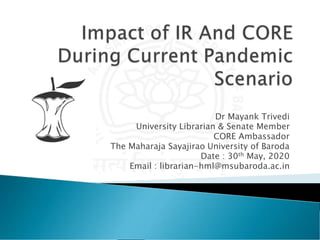The document discusses institutional repositories and their role in managing and disseminating digital materials created by academic institutions and their communities. It provides definitions of institutional repositories by Clifford Lynch, describing them as services offered by universities to manage and distribute digital materials created by the institution and its members with a commitment to long-term preservation. Institutional repositories are centered around academic institutions and contain scholarly works of varying degrees produced by that institution. They aim to maximize access to and preservation of an institution's research outputs.


























































![ “Each individual repository is of limited value for
research: the real power of Open Access lies in the
possibility of connecting and trying together
repositories, which is why we need interoperability.
In order to create a seamless layer of content through
connected repositories from around the world, Open
Access relies on interoperability, the ability for
systems to communicate with each other and pass
information back and forth in a usable format.
Interoperability allows us to exploit today's
computational power so that we can aggregate, data
mine, create new tools and services, and generate
new knowledge from repository content.’’ [COAR
manifesto]](https://image.slidesharecdn.com/core-webinarupdated30-05-2020-200531080623/85/Core-webinar-updated-30-05-2020-59-320.jpg)























